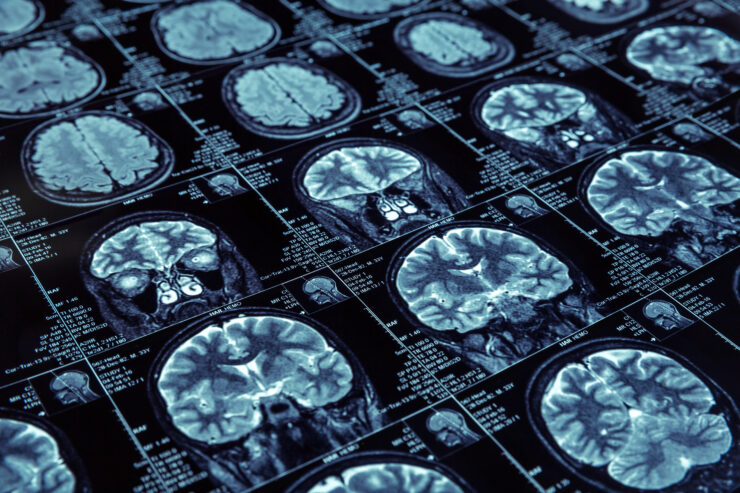A new study, published in “Nature Communications” this week, led by Jake Gavenas PhD, while he was a PhD student at the Brain Institute at Chapman University, and co-authored by two faculty members of the Brain Institute, Uri Maoz and Aaron Schurger, examines how the brain initiates spontaneous actions. In addition to demonstrating how spontaneous action emerges without environmental input, this study has implications for the origins of slow ramping of neural activity before movement onset—a commonly-observed but poorly understood phenomenon.
In their study, Gavenas and colleagues propose an answer to that question. They simulated spontaneous activity in simple neural networks and compared this simulated activity to intracortical recordings of humans when they moved spontaneously. The study results suggest something striking: many rapidly fluctuating neurons can interact in a network to give rise to very slow fluctuations at the level of the population
Imagine, for example, standing atop a high-dive platform and trying to summon the willpower to jump. Nothing in the outside world tells you when to jump; that decision comes from within. At some point you experience deciding to jump and then you jump. In the background, your brain (or, more specifically, your motor cortex) sends electrical signals that cause carefully coordinated muscle contractions across your body, resulting in you running and jumping. But where in the brain do these signals originate, and how do they relate to the conscious experience of willing your body to move?
Starting from the 1960s, neuroscientists have found that electrical activity in the brain ramps up 1-2 seconds before spontaneous voluntary actions. Many scientists thought that the onset of this ramping reflected preparation to move following a preconscious decision to act. But, despite investigations into the origins of this slowly ramping activity, it seemed as though it suddenly emerged “out of nowhere”. In the years since, neuroscientists and philosophers have debated what this ramping means for free will and conscious self-control: if, following an early decision to move, the brain is preparing to move 2 seconds (or more, according to some studies) before you consciously decide to move, might your actions be largely unconsciously predetermined? Understanding the neural origin of this ramping activity is therefore a paramount problem in neuroscience.
The view that there is preconscious information in the brain seconds before action onset has been challenged by neuroscientists like Maoz and Schurger. In particular, in 2012 Schurger suggested that the slow ramping brain activity is part of a larger process, in which slow background fluctuations in motor-cortex activity must reach a certain threshold to initiate movement. If those slow fluctuations help to determine the moment of threshold crossing, then looking back from movement onset ensures that you will observe slow ramping beforehand, even if the ramping is not the outcome of an early preconscious decision to move. In this view, the important event is not the onset of the slow-ramping process but instead the crossing of the threshold. Although compelling, this explanation leaves a key unanswered question: where do these slow background fluctuations in neural activity, commonly known as 1/f noise, come from in the first place, given that the activity of individual neurons fluctuates quite rapidly?
Gavenas’s study is the first to explain how those slow background fluctuations emerge from networks of neurons, where none of the individual neurons by themselves operate on that long of a time-scale. Those slow fluctuations may then, in turn, contribute to a threshold-crossing event, of the kind that is thought to trigger movement, and thus to the slow ramping that is evident before spontaneous action onset and beyond. Gavenas said, “we see similar slow-ramping signals before other kinds of spontaneous behaviors, like coming up with creative ideas or freely remembering things that have happened to you. A similar process might therefore underlie those phenomena, but only time and further research will tell.”
In sum, this is a landmark study because it offers a potential explanation for the origin of slow, spontaneous fluctuations in population-level neural activity, which is a ubiquitous phenomenon in neural systems. In addition, according to Maoz, “It reveals the bias we have as researchers to think that our results uncover a causal mechanism, when it may really be just a correlation.”
About Chapman University
Founded in 1861, Chapman University is a nationally ranked private university in Orange, California, about 30 miles south of Los Angeles. Chapman serves nearly 10,000 undergraduate and graduate students, with a 12:1 student-to-faculty ratio. Students can choose from 123 areas of study within 11 colleges for a personalized education. Chapman is categorized by the Carnegie Classification as an R2 “high research activity” institution. Students at Chapman learn directly from distinguished world-class faculty including Nobel Prize winners, MacArthur fellows, published authors and Academy Award winners. The campus has produced a Rhodes Scholar, been named a top producer of Fulbright Scholars and hosts a chapter of Phi Beta Kappa, the nation’s oldest and most prestigious honor society. Chapman also includes the Harry and Diane Rinker Health Science Campus in Irvine. The university features the No. 4 film school and No. 66 business school in the U.S. Learn more about Chapman University: www.chapman.edu.
Media Contacts
Molly Thrasher. Director of Public Relations | thrasher@chapman.edu | Mobile: 657-561-4359
Carly Murphy, Public Relations Coordinator | carmurphy@chapman.edu| Desk: 714-289-3196 | Mobile: 714-497-9683




